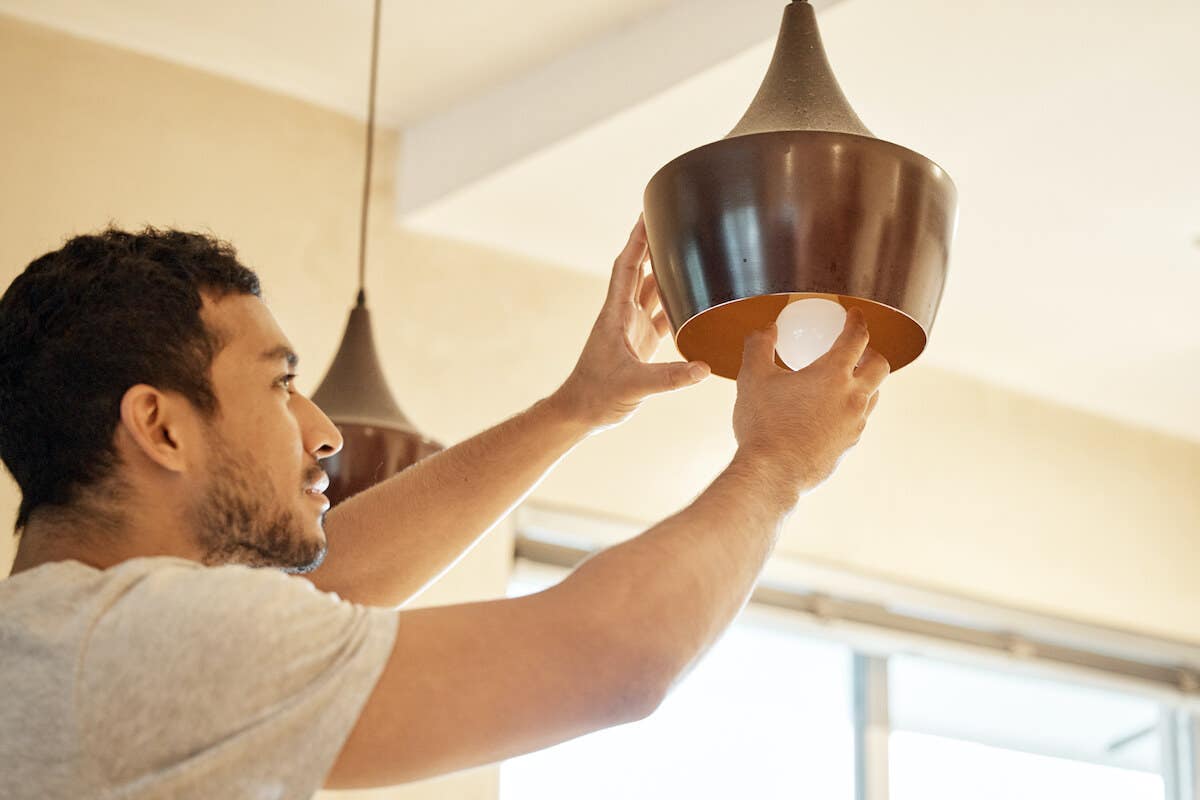Despite the longstanding jokes, changing a lightbulb is pretty easy and should require just one person. But figuring out how to choose a light bulb? That’s a surprisingly different story. From old-fashioned incandescent bulbs to new LED and smart bulbs, it feels like you need a team of experts to pick the best bulb for your situation.
We took a dive into your options to help you better understand what's available and when to use different types of light bulbs.
Why does the right light bulb matter?
The primary concern when choosing a light bulb is illumination. You want to have enough light to make a space functional. But you also want to think about creating the right ambiance for the room. Some bulbs produce brighter, whiter light that makes more sense in a kitchen or bathroom. Other light bulbs give off a warm, yellowish light, which may make them right for a bedroom.
At the same time, you also want to think about the cost and the amount of energy a light bulb consumes. High-efficiency light bulbs are usually more expensive, but use less energy so you buy fewer of them over time. Considering the environmental concerns facing our world, using energy-efficient light bulbs may be the smart choice both for your budget and the greater good.
Types of light bulbs
Let’s take a closer look at the type of light bulbs you can find in your home improvement store.
Incandescent light bulbs
The incandescent light bulb is the original light bulb. It works by heating a filament that glows when hot. While many feel that incandescent bulbs are archaic, they’re still popular because they’re inexpensive and easy to use. People generally like that incandescent light bulbs dim easily with a simple device called a rheostat and the warm ambiance they produce compared to new technology bulbs.
Incandescent bulbs saw a resurgence in popularity when Edison bulbs became a trendy lighting option. However, the Energy Independence and Security Act of 2007 set maximum power consumption that reduced the number of incandescent bulbs made. Incandescent light bulbs are still available, but many homeowners have shifted towards more energy-efficient bulbs.
Halogen light bulbs
A halogen light bulb is similar to an incandescent bulb where current flows along a filament, heating it up until it glows. But halogens actually have an internal bulb that’s a quartz capsule filled with halogen gas. The internal system used by halogen bulbs means that they are able to reuse the elements internally and last longer to 4,000 hours compared to just 750 to 2,000 hours for incandescent bulbs.
Compact fluorescent lamp (CFL) bulbs
CFL bulbs were the first wave in light bulb technology that produced a high light output while helping conserve energy. As the name suggests, this is a fluorescent bulb that lasts longer than traditional incandescent bulbs. In fact, they are thought to last ten times longer than incandescent bulbs, making the case for their more expensive purchase price.
Homeowners like CFL bulbs for savings over time but also because they can use CFLs in hard-to-reach sockets where changing more frequently can prove challenging. However, the early versions produced harsh light that turned many people off. Plus, CFL bulbs contain a tiny amount of mercury that can be released if the bulb is broken.
Light-emitting diode (LED) bulbs
LED bulbs are taking over the aisles in many home improvement stores. These bulbs are nearly 90 percent more efficient than incandescent bulbs and they last up to 50,000 hours. On top of their ability to reduce your energy bill, LEDs don’t contain mercury and they come in a variety of shapes and styles.
You can also get internet-capable LED bulbs, called smart bulbs, that can turn on and off, dim or brighten, and even change color depending on how you program them. These benefits make LED lights a popular choice with homeowners, despite the steep upfront costs. The price, however, is balanced out by the energy savings over time.
Wattage vs. Lumens explained
Traditionally, light bulbs were sold based on wattage. You’d go out to buy a 60- or 80-watt bulb, knowing that the higher wattage meant a brighter bulb. But wattage describes electricity consumption so as more energy-efficient bulbs came to market, wattage became a less useful description for light bulbs. After all, new light bulbs use less energy to provide the same, if not more, light.
This is where measuring lumens is important. Lumens are the amount of light generated by a light bulb. Incandescent bulbs produce approximately 15 lumens per watt, and LEDs produce about 60 lumens per watt, so it use less energy to provide more light. Understanding this helps you decide how many light bulbs to buy. But remember﹘fixtures have safety ratings that limit the number of watts they can take. Never use a bulb that exceeds a fixture’s safety rating.
The table below is a light bulb wattage guide. Across the top, it lists four common light bulbs (incandescent, halogen, CFL, and LED) with the wattage you’d need to get the lumens listed in the far left column.
Light bulb wattage guide
| Lumens | Incandescent | Halogen | CFL | LED |
|---|---|---|---|---|
| 220 | 25w | 18w | 5w | 4.5w |
| 410 | 40w | 28w | 8w | 9w |
| 700 | 60w | 42w | 12w | 13w |
| 920 | 75w | 53w | 15w | 13w |
| 1330 | 100w | 70w | 20w | 18w |
Source: Display Smart, LLC. Understanding Display Case LED Lighting Terminology Sept. 24, 2021.
Other things to consider when picking a light bulb
Knowing the different types of bulbs is just step one to picking the right one for you. The next is to think about where you need light, how much light that area needs, and what kind of fixtures you have available to you. Your answers to these questions can help you choose a light bulb with the right:
- Color and brightness. Even white light can produce different colors. These generally fall between a soft, yellow to a neutral white to a bright, slightly bluish light. Certain rooms, like kitchens, garages, and bathrooms, often need bright, whiter light.
- Fixtures. Light bulbs can react differently to heat. LEDs, for example, are sensitive to heat and might not work well or last as long in recessed or enclosed fixtures. Fixtures also have safety ratings, so you need to buy light bulbs that do not exceed the watt limit.
- Fitting. The most common fitting is the Edison screw where a bulb with a threaded base screws into a matching socket. However, halogen and LED bulbs may have GU10 fittings, which are installed with a light push and slight turn. You should also note that not every light bulb is compatible with a dimmer, so be sure to check before you buy.
LED light bulbs seem like a clear winner in many situations because they’re cost-effective and versatile. That said, you may find them less useful if you have particular fixtures or require certain fittings.


